Pool Removal Cost: The Financial Minefield Nobody Warns You About
With pool removal cost ranging from $3,000 to $20,000 according to recent industry data, homeowners face a complex financial landscape that extends far beyond simple excavation expenses. The average cost of removing a pool in the United States is approximately $10,000, but this figure barely scratches the surface of the true financial commitment involved.
Table of Contents
- The Bureaucratic Nightmare That Eats Your Budget
- When Your Pool Becomes a Treasure Hunt (And Who Pays)
- Insurance Roulette: The Coverage Gaps That Could Bankrupt You
- Turning Removal Into Your Best Investment Decision
TL;DR
- Pool removal costs extend far beyond excavation – regulatory compliance alone can add 15-25% to your total budget through permits, inspections, and mandatory assessments
- Material recovery has transformed pool removal into a potential profit center, with metal harvesting and concrete crushing offsetting thousands in removal costs
- Insurance gaps during removal create liability exposure that most homeowners never consider, potentially leaving you unprotected for weeks
- Strategic post-removal planning can turn your former pool area into a property value goldmine, with ADU potential adding $100,000-300,000 to your home’s worth
- Hidden costs like utility standby fees, archaeological surveys, and engineered fill requirements can double your initial budget estimates
The Bureaucratic Nightmare That Eats Your Budget
Most homeowners think pool removal is just about digging and filling, but I’ve learned the hard way that government red tape often becomes the most expensive part of the entire project. The permitting process alone can consume 15-25% of your total budget while adding months to your timeline. What starts as a simple removal project quickly becomes a complex dance with multiple municipal departments, each demanding their own fees, inspections, and compliance measures.
I’ve watched neighbors get blindsided by permit requirements they never saw coming. The city doesn’t just hand you one permit and wish you luck. You’re dealing with building departments, planning commissions, environmental agencies, and utility companies – all operating on different timelines with their own fee structures.
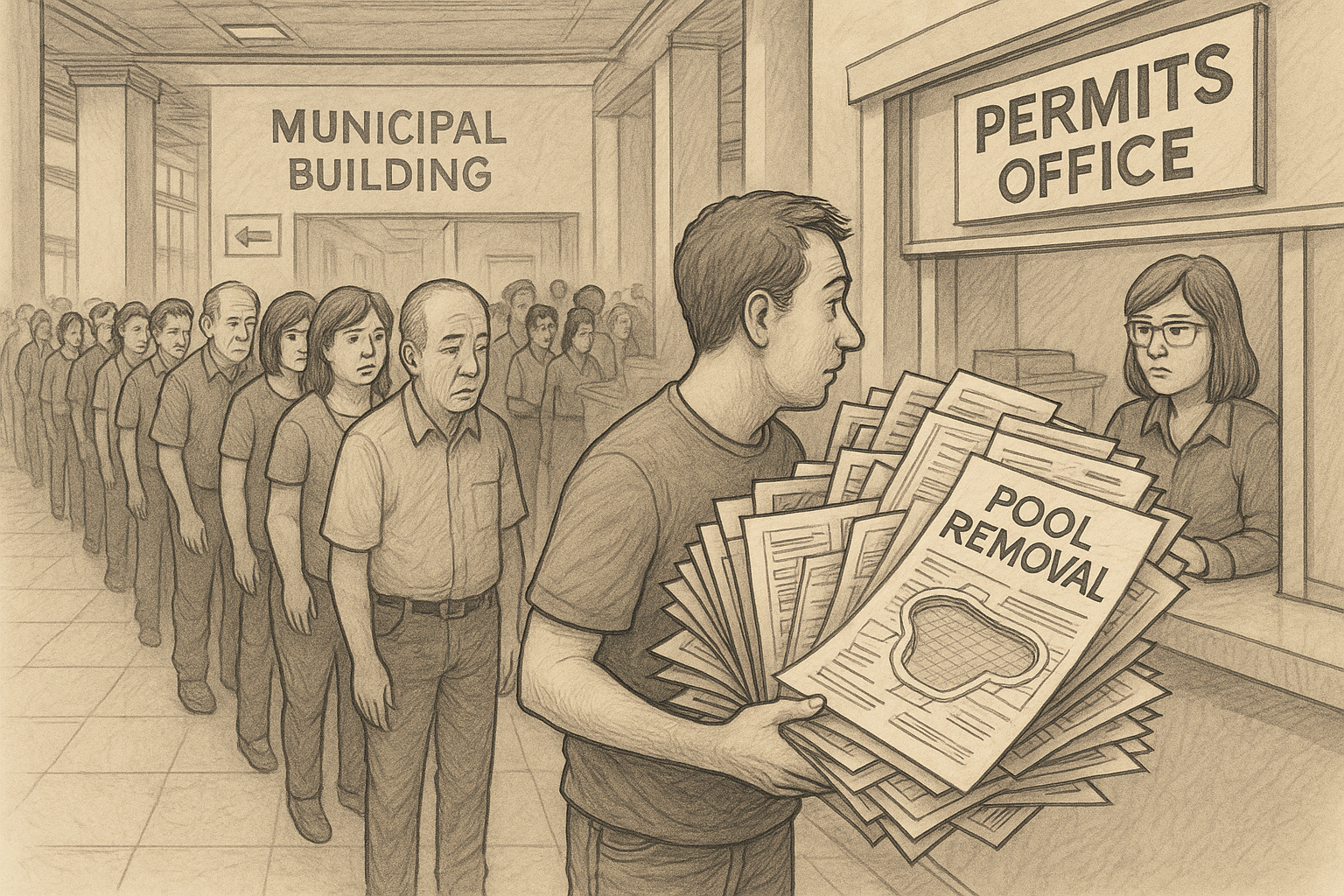
Breaking Through Municipal Code Maze Without Going Broke
Pool removal isn’t just one permit – it’s a cascade of approvals from different city departments that don’t always communicate with each other. Each department has its own timeline, requirements, and fee structure. I’ve seen projects stall for months because homeowners didn’t realize they needed approval from planning, building, environmental, and utilities departments separately.
The planning department wants to know how your removal affects zoning compliance and setback requirements. Building departments focus on structural impacts and safety protocols. Environmental agencies worry about soil contamination and groundwater protection. Utilities demand their own inspections and standby requirements.
Understanding the true scope of swimming pool removal cost becomes even more complex when you factor in construction debris removal requirements that many contractors don’t fully explain upfront. The debris alone can fill multiple dumpsters, and disposal fees vary dramatically based on your location and the materials involved.
| Department | Permit Type | Cost Range | Timeline | Requirements |
|---|---|---|---|---|
| Building | Demolition Permit | $200-$400 | 1-3 weeks | Site plan, contractor license |
| Planning | Zoning Review | $150-$300 | 2-4 weeks | Property survey, setback verification |
| Environmental | Soil Assessment | $500-$1,500 | 3-6 weeks | Contamination testing, groundwater analysis |
| Utilities | Service Disconnection | $300-$800 | 1-2 weeks | Electrical inspection, gas line verification |
| Public Works | Right-of-Way Impact | $100-$500 | 1-3 weeks | Traffic plan, sidewalk protection |
The Utility Company Shakedown You Never Saw Coming
That simple “call before you dig” requirement turns into a financial nightmare when utilities demand specialized inspections and standby crews for pool removal. These aren’t your typical utility markings – pool removal triggers enhanced protocols that can cost thousands in mandatory fees you can’t avoid.
Beyond the standard 811 call, pool removal requires specialized utility protocols that’ll hit your wallet hard. Utility companies charge standby fees ranging from $500-2,000 because they need crews on-site during excavation near their lines. Gas companies are particularly expensive – they often require continuous monitoring when you’re digging within 10 feet of their mains.
Electric utilities add another layer of complexity. If your pool has underwater lighting or electrical systems, they’ll demand a formal disconnection inspection before removal begins. This isn’t something your contractor can handle – it requires a utility representative who bills by the hour.
The cost of removing inground swimming pool projects gets complicated when you discover that some utility companies require you to pay for their time even when they’re just standing around watching. I’ve seen homeowners get bills for $800 just because the gas company required a technician to monitor excavation for three hours.
According to Creative Edge Pools, permit fees can range from $200 for basic removal permits to $75 for dumpster permits, with disposal costs adding another $300-$500 to your total project budget.
When City Engineers Hold Your Project Hostage
Modern municipalities increasingly require structural engineering assessments for pool removal, especially when pools sit close to property lines or foundations. These aren’t quick rubber-stamp approvals – they’re comprehensive studies that can cost thousands and take weeks to complete.
Structural impact studies have become the new normal for pool removal projects. Cities want to know how much does it cost to remove a pool when you factor in potential damage to surrounding foundations, retaining walls, and neighboring properties. These studies cost $1,500-4,000 and require licensed structural engineers.
The assessment process involves soil analysis, foundation proximity calculations, and impact modeling. Engineers need to verify that removal won’t cause settling or shifting that could damage nearby structures. Some municipalities won’t issue removal permits without these studies, regardless of your pool’s age or location.
Consider the Johnson family in Westchester County, who thought their pool removal would cost $8,000. After the city required a structural engineering study due to their pool’s proximity to their neighbor’s foundation, they faced an additional $3,200 in assessment fees and a six-week delay while engineers evaluated potential soil displacement impacts.
Environmental Compliance: The Surprise Tax on Older Pools
Pools built before 1990 often trigger environmental impact requirements that can add thousands to your removal cost. These regulations focus on potential soil contamination and groundwater protection, requiring specialized testing and documentation that most homeowners never anticipate.
Environmental regulations hit older pools particularly hard. Municipalities now require soil contamination testing for pools built before environmental standards tightened. This testing looks for chemical residues from decades of pool treatments, potential lead paint contamination, and groundwater impact.
The testing process involves multiple soil samples from different depths around your pool. Laboratory analysis costs $2,000-5,000 depending on your area’s requirements. If contamination is found, remediation costs can explode into tens of thousands of dollars.
Groundwater impact assessments add another layer of expense. Environmental consultants must evaluate how in-ground pool removal will affect local water tables and drainage patterns. This is particularly expensive in areas with high water tables or environmental sensitivity.
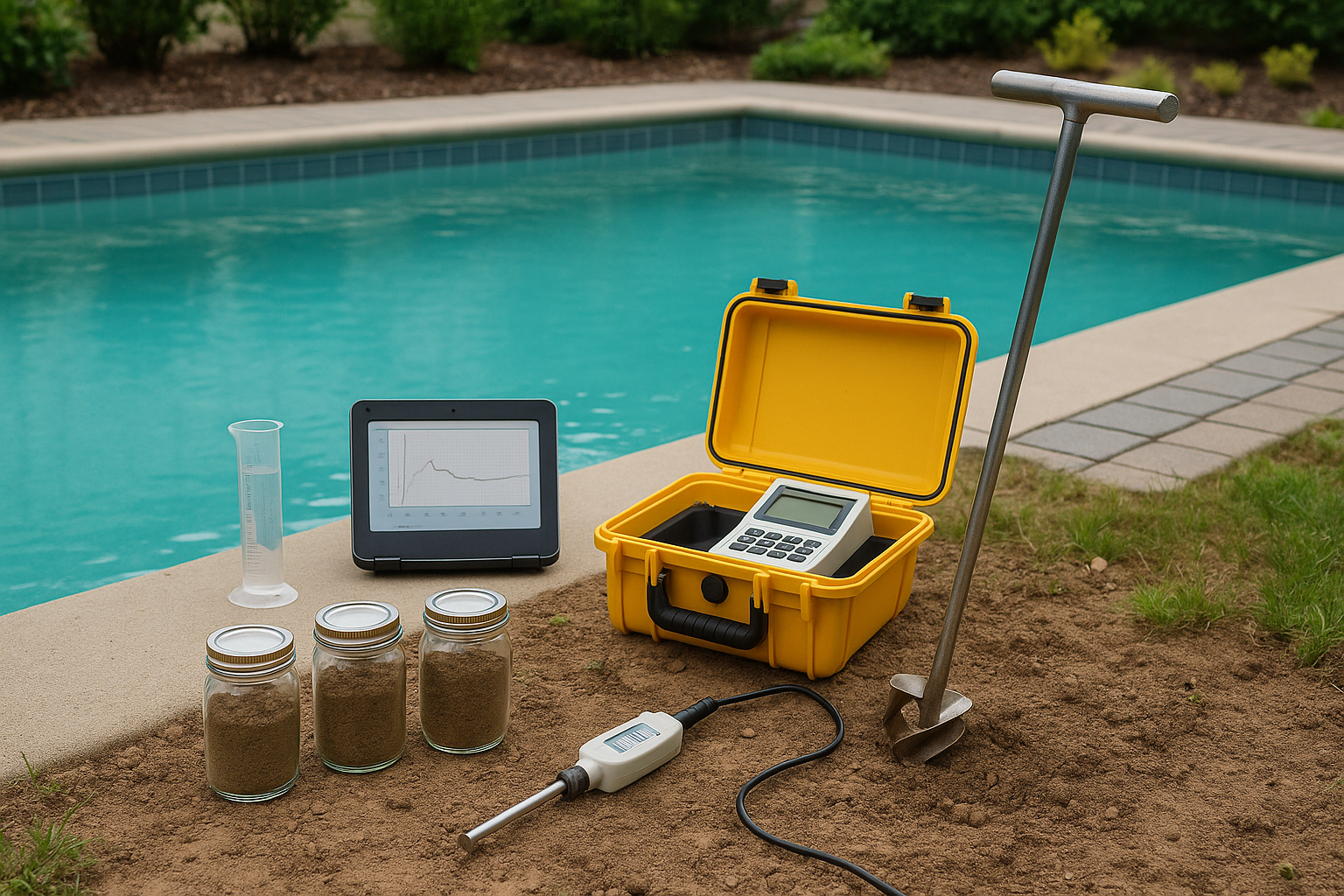
Digging Up the Past: When Missing Records Cost Thousands
The absence of original construction records can transform a straightforward removal into an archaeological expedition. Without knowing exactly what’s buried in your backyard, cities require extensive surveys and investigations that can cost more than the actual pool removal work.
I’ve seen homeowners discover that their “simple” pool removal project required ground-penetrating radar, archaeological surveys, and utility mapping because the previous owner never kept proper construction records. These investigations can easily add $5,000-10,000 to your project cost.
Archaeological Surveys: Digging for History and Your Money
Archaeological survey requirements catch most homeowners completely off guard. If your property is over 50 years old or located in a historically significant area, you might need archaeological clearance before breaking ground. These surveys cost $3,000-8,000 and can take weeks to complete.
The survey process involves historical research, ground-penetrating radar, and sometimes test excavations. Archaeologists need to verify that pool removal won’t disturb significant historical artifacts or sites. Even if nothing is found, you’re still responsible for the full survey cost.
Some areas have streamlined processes for residential pool removal, but others treat every project as a potential archaeological site. Check with your local historical society and planning department early in the process to avoid surprises.
Ground Penetrating Radar: The High-Tech Treasure Hunt
When original utility plans are missing or unreliable, ground penetrating radar becomes mandatory for safe pool removal. This technology can map underground utilities with precision, but the cost often shocks homeowners who assumed their contractor would handle utility location.
Ground penetrating radar (GPR) surveys have become essential when original construction records are unavailable. These surveys cost $1,200-3,500 but provide detailed mapping of underground utilities, old foundations, and other buried obstacles that could complicate removal.
GPR technology can identify utility lines, septic systems, old foundations, and even buried debris from previous construction. This information is crucial for safe excavation and helps contractors avoid costly utility strikes or unexpected obstacles.
The survey process typically takes 1-2 days and produces detailed maps showing everything buried around your pool. While expensive, GPR surveys often save money by preventing utility damage and excavation complications that could significantly increase your in-ground pool removal cost.
Neighbor Relations: The Legal Landmines Next Door
Pool removal can trigger easement disputes and legal complications with neighbors that most homeowners never consider. Shared utilities, property line issues, and construction impacts can create expensive legal battles that drag on for months.
Shared Utility Easements: When Your Neighbors Control Your Timeline
Shared utility easements create the most complex legal challenges in pool removal. If your pool was built over easements that serve neighboring properties, you’ll need formal consent from affected neighbors and utility companies before removal can begin.
The consent process isn’t just a friendly conversation – it requires legal documentation, utility company approval, and sometimes formal easement modifications. Legal fees for easement issues typically range from $2,000-6,000, and the process can take months.
Neighbors sometimes use easement rights as leverage in disputes or demand compensation for temporary utility disruptions. These negotiations can become expensive and time-consuming, especially if legal mediation becomes necessary.
When dealing with complex pool demolition costs, many homeowners discover they need professional commercial junk removal services to handle the massive amount of debris generated during the process.
Recent pool removal projects have highlighted the complexity of municipal oversight. The “Fox Point Municipal Pool demolition” Journal Sentinel demonstrates how even municipal projects face regulatory challenges, with the village approving a $165,000 contract with WSO Grading and Excavation while navigating complex approval processes.
When Your Pool Becomes a Treasure Hunt (And Who Pays)
The economics of pool removal have completely shifted in recent years. What used to be pure demolition and disposal has become a material recovery operation where smart homeowners can offset thousands in removal costs. The key is understanding which materials have value and how to capture that value during the removal process.
I’ve watched contractors who understand material recovery reduce homeowner costs by $3,000-7,000 through systematic metal harvesting and concrete processing. The difference between a contractor who throws everything in a dumpster versus one who separates valuable materials can dramatically impact your final bill.
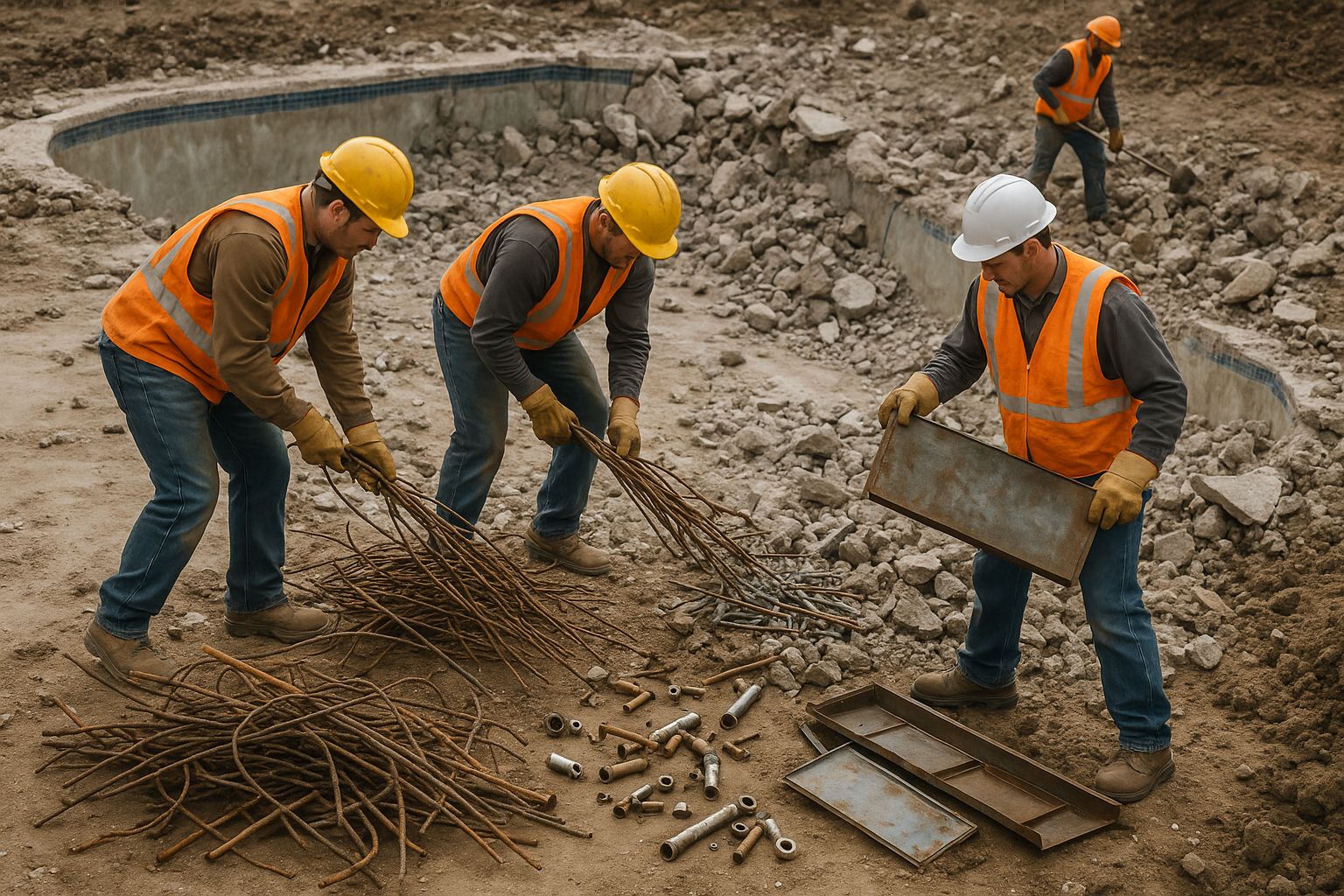
Mining Your Pool: The Hidden Value in Concrete and Steel
Modern pool removal operates more as a mining operation than simple demolition. Contractors who understand material recovery can significantly reduce your costs by harvesting valuable metals and processing concrete on-site. The challenge is finding contractors who prioritize recovery over speed.
Most pool removal contractors focus on getting the job done quickly rather than maximizing material recovery. This approach costs homeowners thousands in missed opportunities to offset removal expenses through scrap metal sales and concrete recycling.
Rebar Recovery: Turning Reinforcement Into Cash
Rebar and metal component harvesting can offset $1,500-4,000 in removal costs, but only if your contractor uses systematic separation techniques. Most pool removal contractors focus on speed over recovery, missing this opportunity to reduce your costs.
The key is finding contractors who invest in metal separation equipment and have relationships with scrap dealers. They’ll carefully separate rebar during demolition rather than mixing it with concrete for disposal. This process takes longer but can significantly reduce your final bill.
Pool equipment such as pumps, heaters, and filtration systems also have scrap value. Copper plumbing and electrical components can be particularly valuable. Make sure your contractor accounts for metal recovery in their pricing structure.
Professional scrap metal pick up services can help maximize the value recovery from your pool removal project, ensuring valuable materials don’t end up in landfills.
According to GetASitePlan, the average cost to fill a pool ranges from $3,000 to $10,000, with gravel costing $6 to $10 per cubic yard and dirt fill ranging from $10 to $15 per cubic yard, making material recovery even more valuable for offsetting these expenses.
On-Site Concrete Crushing: Creating Value From Waste
On-site concrete crushing can reduce disposal costs by 60-80% while creating sellable aggregate material. The upfront equipment rental costs are significant, but the savings on disposal fees and the potential revenue from selling crushed concrete can make this approach profitable for larger pools.
On-site concrete crushing transforms your pool removal from a disposal problem into a material production operation. Portable crushing equipment can process your pool’s concrete into sellable aggregate, reducing disposal costs by 60-80%.
The crushing process requires specialized equipment rental costing $2,000-5,000 upfront, but the savings on disposal fees often exceed this cost. Crushed concrete sells for $8-15 per ton, and a typical pool generates 50-100 tons of concrete.
Crushed concrete has multiple uses – it’s perfect for driveways, walkways, and landscaping projects. Some contractors will buy the crushed material directly, further offsetting your pool demolition cost. The key is planning for crushing from the beginning of your project.
Salvaging the Decorative Elements: Vintage Tiles and Natural Stone
Vintage pool tiles and natural stone coping have surprising resale value in today’s renovation market. Careful salvage during removal can offset $500-3,000 in costs while keeping beautiful materials out of landfills.
Mid-century pool tiles are particularly valuable to restoration enthusiasts and designers. Natural stone coping, especially travertine and flagstone, maintains good resale value even after years of pool use. The key is careful removal that preserves the materials’ integrity.
Online marketplaces and architectural salvage companies provide ready markets for quality pool materials. Some contractors specialize in material recovery and will share the proceeds with homeowners. This approach takes more time but can significantly reduce your net removal cost.
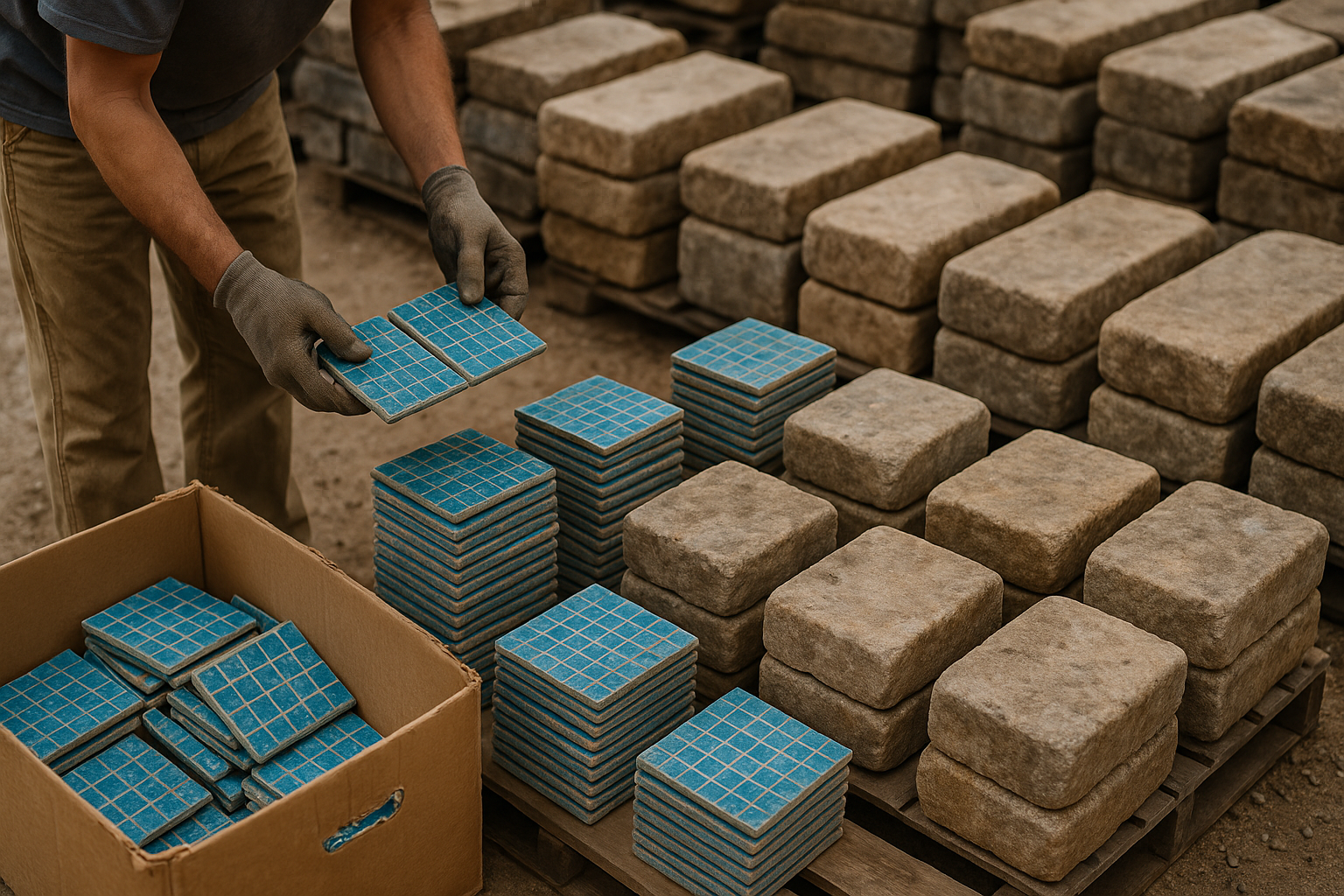
The Soil Equation: Understanding Fill and Compaction Costs
Pool removal creates a massive void that must be filled with appropriate materials and properly compacted to prevent future settling. Modern building codes have strict requirements for engineered fill and compaction testing that can add thousands to your project cost.
The typical residential pool requires 200-500 cubic yards of fill material. When you multiply that by the cost difference between regular dirt and engineered fill, you’re looking at thousands of additional dollars that most homeowners never budget for.
Engineered Fill Requirements: Why Dirt Isn’t Just Dirt
Modern building codes increasingly require engineered fill rather than native soil for pool backfill. This specialized material costs significantly more than regular dirt but provides the stability and drainage characteristics necessary to prevent future foundation problems.
Engineered fill requirements have transformed pool backfill from a simple dirt operation into a precision engineering project. Modern codes require specific soil compositions that provide proper drainage and compaction characteristics, adding $3-8 per cubic yard to material costs.
The typical pool requires 200-500 cubic yards of fill material, making engineered fill a significant expense. However, using proper fill prevents future settling that could damage foundations, driveways, or landscaping. The upfront cost prevents much larger future expenses.
Engineered fill specifications vary by location and soil conditions. Some areas require specific sand and gravel mixtures, while others mandate imported clay or specialized drainage materials. Your contractor should provide detailed specifications for the required fill materials.
The Martinez family in Phoenix discovered this reality when their contractor explained that Arizona’s expansive clay soils required specialized engineered fill costing $12 per cubic yard instead of standard dirt at $6 per cubic yard. For their 20×40 foot pool, this added $3,600 to their project, but prevented potential foundation damage that could have cost $15,000 to repair.
Compaction Testing: The Quality Control That Costs Extra
Soil compaction must meet specific engineering standards to prevent future settling and foundation problems. This requires multiple testing phases throughout the backfill process, adding significant costs but providing essential quality assurance for your property’s long-term stability.
Compaction testing and certification add $1,500-3,500 to pool removal costs but provide essential quality assurance. Testing occurs in multiple phases as fill material is placed and compacted in lifts throughout the backfill process.
Professional testing involves soil density measurements, moisture content analysis, and compaction verification at specified intervals. Each test costs $200-400, and most projects require 5-10 tests depending on the pool size and local requirements.
Failed compaction tests require rework that can add thousands to your project cost. Proper testing prevents future settling that could damage your foundation, driveway, or new landscaping. The testing cost is insurance against much larger future problems when considering how much does pool removal cost in total.
| Fill Material Type | Cost per Cubic Yard | Compaction Rating | Best Use Case | Drainage Properties |
|---|---|---|---|---|
| Native Soil | $6-$10 | Poor | Landscaping only | Variable |
| Sand/Gravel Mix | $12-$18 | Good | General backfill | Excellent |
| Engineered Fill | $15-$25 | Excellent | Building sites | Controlled |
| Concrete Rubble | $8-$12 | Fair | Non-building areas | Good |
| Clay-Based Mix | $10-$16 | Good | Wet climates | Poor |
Insurance Roulette: The Coverage Gaps That Could Bankrupt You
Pool removal creates a complex web of insurance implications that most homeowners never consider. The removal process temporarily increases your property’s risk profile while potentially creating coverage gaps that could leave you financially exposed. Understanding these risks before starting your project can prevent devastating financial surprises.
I’ve seen homeowners discover too late that their standard homeowner’s policy doesn’t cover certain types of damage during pool removal. The 2-6 week removal window creates unique liability exposures that require careful planning and potentially additional coverage.

Your Homeowner’s Policy During the Danger Zone
The 2-6 week pool removal window creates elevated liability exposure that your standard homeowner’s policy may not fully cover. Open excavations, heavy equipment, and construction activity all increase risk while potentially voiding certain aspects of your existing coverage.
Pool removal transforms your backyard into a construction zone with heavy machinery, open excavations, and constant worker activity. This dramatically changes your property’s risk profile in ways that standard homeowner’s policies weren’t designed to handle.
Temporary Liability Exposure: When Your Backyard Becomes a Hazard
The removal process creates a 2-6 week window of elevated liability exposure that many homeowner’s policies don’t adequately address. Open excavations, heavy equipment operation, and construction debris create hazards that could result in serious injuries to workers, neighbors, or trespassers.
Standard homeowner’s policies may exclude coverage for construction-related incidents or limit coverage during major alterations. Additional liability coverage during removal typically costs $500-1,500 but provides essential protection against potentially devastating claims.
The liability exposure extends beyond your property boundaries. Heavy equipment can damage neighboring properties, and excavation can affect adjacent foundations or utilities. Make sure your coverage addresses these extended risks before work begins.
When considering pool removal, homeowners should also plan for proper debris removal services to minimize liability exposure from construction waste and materials.
Recent events in Arizona highlight growing environmental concerns about pool ownership. “Saying goodbye to backyard swimming pools” AZPM reports that about one in six residents with backyard pools are considering removal due to financial costs and environmental concerns, with local water authorities establishing poolremovalhelp.org to provide guidance.
Property Value Fluctuation: The Coverage Gap Nobody Mentions
Some insurance policies exclude coverage for property value changes during major alterations such as pool removal. This gap could leave you uninsured for tens of thousands in potential losses if complications arise during the removal process.
Property value fluctuation coverage represents one of the most overlooked risks in pool removal. Some policies exclude coverage for property value changes during major alterations, potentially exposing homeowners to $10,000-50,000 in uninsured losses.
Pool removal can temporarily reduce your property value, especially if complications arise or the project stalls. If your home is damaged during removal or market conditions change, you might not have coverage for the resulting value loss.
Review your policy’s exclusions carefully and consider additional coverage for major alterations. Some insurers offer specific endorsements for construction projects that provide broader protection during the removal process, which should be factored into how much does pool removal cost overall.
Contractor Insurance: The Protection You’re Paying For
Pool removal contractors operate in a specialized risk category that requires enhanced insurance coverage and bonding arrangements. Verifying proper coverage protects you from liability while ensuring your contractor can handle potential complications without passing costs to you.
Environmental Liability: The Contamination Coverage You Need
Environmental liability insurance has become essential for pool removal contractors due to increasing environmental regulations and contamination risks. This specialized coverage protects against groundwater contamination, soil remediation costs, and environmental cleanup requirements.
The insurance typically adds 8-15% to total project costs but provides protection against environmental issues that could cost tens of thousands to remediate. Without proper coverage, homeowners might be responsible for contamination cleanup even if caused by contractor negligence.
Verify that your contractor carries adequate environmental liability coverage before work begins. The policy should cover both sudden contamination events and gradual pollution that might be discovered during or after removal.
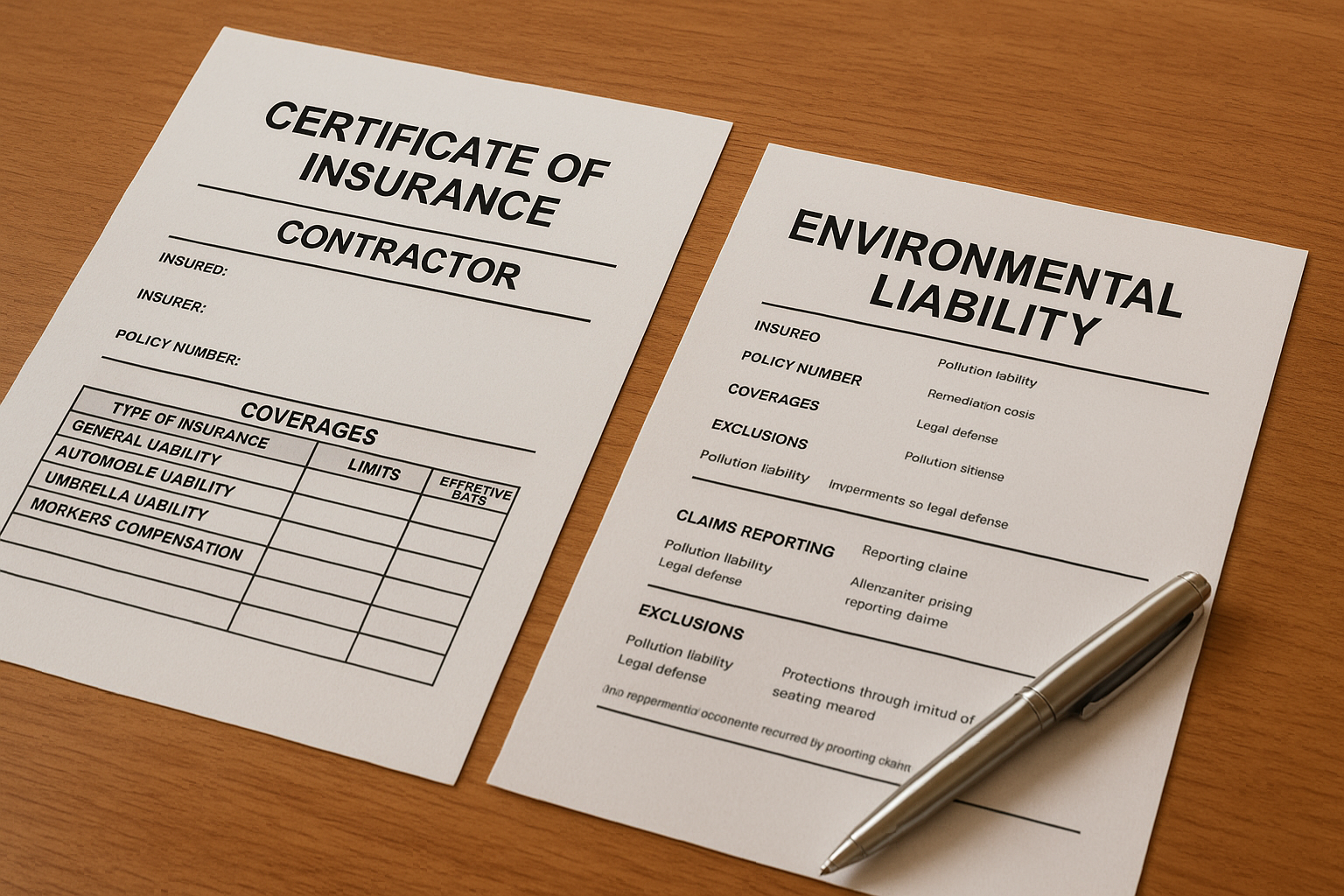
Structural Damage Bonding: Insurance Against Foundation Problems
Structural damage bonding protects against foundation damage, utility strikes, and neighboring property damage during pool removal. This bonding typically adds 3-7% to total project costs but provides essential protection against expensive complications.
The bonding covers repair costs for foundation cracks, utility line damage, and structural issues affecting neighboring properties. Without proper bonding, homeowners might be responsible for repair costs even when damage results from contractor error.
Bonding requirements vary by location and project scope. Larger projects or those near property lines typically require higher bonding amounts. Verify bonding coverage before work begins and understand what types of damage are covered.
According to Steve’s Services LLC, the average cost of removing an inground swimming pool ranges from $5,000 to $7,000, with full removal costing $10,000 to $15,000 on average, making proper insurance coverage crucial for protecting these significant investments.
Turning Removal Into Your Best Investment Decision
The land use potential unlocked by pool removal represents the most significant but least understood component of the total cost-benefit equation. Strategic planning for your former pool area can transform removal from an expense into a value-creation opportunity that significantly increases your property’s worth and functionality.
I’ve seen homeowners turn pool removal projects into six-figure property value increases through smart post-removal development. The key is thinking beyond just filling the hole and considering what that space could become.
Pool removal opens up possibilities that most homeowners never consider. That 600-1,200 square feet of prime backyard real estate can become anything from an accessory dwelling unit to a sustainable garden that reduces your monthly expenses.
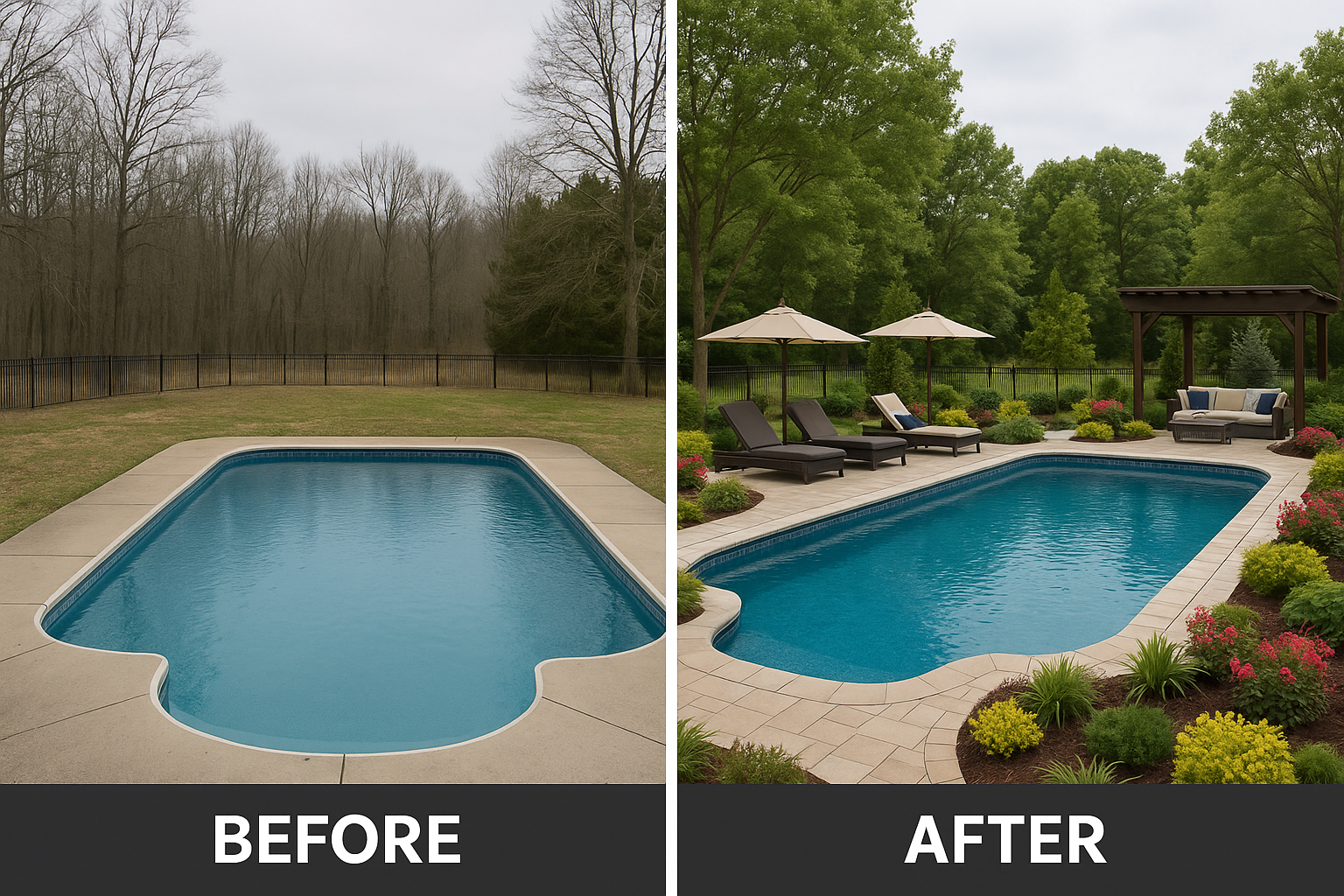
Immediate Site Restoration: Setting the Stage for Success
The approach you take to immediate site restoration determines both your short-term costs and long-term property value optimization. Professional planning during the restoration phase can multiply your property value gains while preventing costly problems down the road.
Pool removal creates a blank canvas, but what you do with that canvas in the first few months determines whether you’ve made a smart investment or just eliminated a problem.
Landscape Architecture Integration: Designing for Maximum Value
Professional landscape design for former pool areas requires significant upfront investment but can double or triple your property value gains. The key is creating integrated outdoor spaces that feel intentional rather than afterthoughts to pool removal.
Professional landscape architecture integration can add $5,000-15,000 to your upfront costs but increase property values by $20,000-40,000 when done strategically. The key is creating cohesive outdoor spaces that feel intentional rather than pool removal afterthoughts.
Landscape architects understand how to maximize the unique opportunities created by pool removal. Former pool areas often have excellent sun exposure, existing hardscaping, and established sight lines that can be leveraged for high-value outdoor living spaces.
The design process should begin before removal to ensure proper grading, utility placement, and drainage integration. This coordination prevents costly rework and creates seamless transitions between removal and restoration phases.
Professional yard waste removal services become essential during the landscaping phase following pool removal, ensuring clean installation of new features.
Drainage System Redesign: Preventing Future Foundation Problems
Former pool areas often require comprehensive drainage solutions to prevent water accumulation and foundation problems. While these systems add $3,000-8,000 to your immediate costs, they prevent much more expensive foundation repairs and provide long-term property protection.
Drainage system redesign becomes critical in former pool areas because removal eliminates the pool’s role as a water collection point. Comprehensive drainage solutions cost $3,000-8,000 but prevent foundation issues that could cost tens of thousands to repair.
The drainage design must account for changed water flow patterns, soil compaction differences, and seasonal water accumulation. French drains, surface grading, and retention systems all play roles in effective drainage management.
Proper drainage design also creates opportunities for water feature integration, rain gardens, and sustainable landscaping elements that add property value while managing water effectively. Using a pool removal cost calculator should include these drainage considerations for accurate project budgeting.
The Chen family in Seattle transformed their former pool area into a rain garden that manages stormwater runoff while creating a beautiful native plant habitat. The $8,500 drainage system installation prevented potential basement flooding issues and added $18,000 to their property value while reducing their annual water bills by $400.
Utility Infrastructure Repurposing: Maximizing Existing Investments
Utility infrastructure repurposing can save $2,000-5,000 in new installation costs while creating valuable outdoor amenities. Pool electrical systems can power outdoor kitchens, lighting systems, or workshop spaces. Plumbing can serve outdoor sinks, irrigation systems, or water features.
The key is planning utility repurposing before removal begins. Contractors can preserve and relocate utility connections during the removal process, making future installations much less expensive and disruptive.
Gas lines for pool heaters can be repurposed for outdoor grills or fire features. Electrical systems can power landscape lighting or outdoor entertainment areas. Water lines can serve irrigation systems or outdoor cleaning stations.
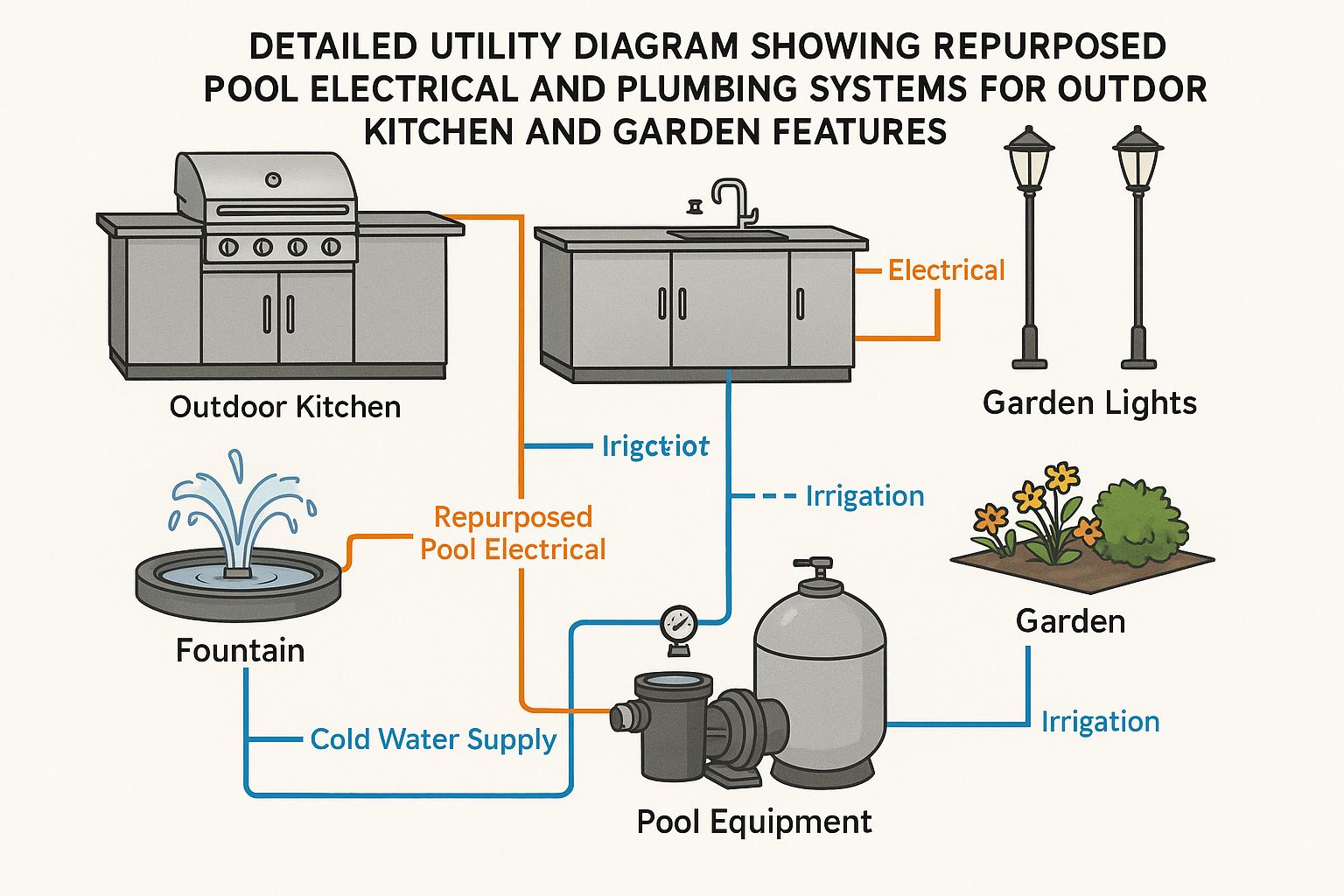
Long-Term Property Value Optimization: The Big Picture Strategy
Strategic post-removal development can transform pool removal from a cost center into a value-creation opportunity. The key is understanding your property’s highest and best use potential and planning removal to support those long-term goals.
Pool removal should be viewed as the first step in a larger property optimization strategy rather than just eliminating an unwanted feature.
ADU Development Potential: The Ultimate Value Play
Former pool areas often provide ideal footprints for accessory dwelling units that can add hundreds of thousands in property value. The key is planning removal with ADU development in mind to minimize future site preparation costs.
ADU development potential represents the ultimate value creation opportunity for pool removal projects. Former pool areas often provide ideal footprints for accessory dwelling units, potentially adding $100,000-300,000 in property value.
Pool areas typically have excellent utility access, privacy screening, and separation from main houses that make them perfect for ADU development. The removal process can be planned to support future construction, minimizing site preparation costs.
ADU regulations vary significantly by location, but many areas have relaxed restrictions to encourage additional housing. Research local ADU requirements early in the planning process to ensure your removal supports future development potential. This long-term value creation should be considered when evaluating how much does pool removal cost versus the return on investment.
When planning ADU development after pool removal, professional estate cleanout services can help prepare existing structures and clear space for new construction.
Sustainable Landscaping ROI: The Gift That Keeps Giving
Sustainable landscaping in former pool areas can reduce water costs by $2,000-5,000 annually while increasing property appeal and market value. The key is selecting drought-resistant plants and efficient irrigation systems that provide beauty without ongoing expense.
Former pool areas often have excellent microclimates for sustainable landscaping. Existing hardscaping, wind protection, and sun exposure can be leveraged to create low-maintenance gardens that thrive with minimal water input.
The landscaping investment pays dividends through reduced maintenance costs, increased property appeal, and environmental benefits. Native plant gardens, xeriscaping, and efficient irrigation systems all contribute to long-term value creation following pool removal.

Pool Removal Project Planning Checklist:
- Obtain structural engineering assessment if required
- Secure all necessary permits from multiple departments
- Verify contractor insurance and bonding coverage
- Plan material recovery and recycling opportunities
- Design drainage system for post-removal area
- Coordinate utility disconnection and potential repurposing
- Schedule compaction testing throughout backfill process
- Plan landscape architecture integration
- Research ADU development potential
- Budget for 25% contingency above quoted costs
When you’re dealing with the massive debris removal that comes with pool removal, JiffyJunk’s comprehensive hauling services can eliminate one of the biggest headaches in your project. We handle everything from pool equipment and accessories to construction debris, ensuring your removal project stays on schedule without debris becoming a bottleneck.
Our systematic approach to material sorting can help you capture value from recyclable materials while ensuring proper disposal of everything else. Ready to streamline your pool removal project? Contact JiffyJunk today for a free estimate on comprehensive debris management services.
Final Thoughts
Pool removal cost extends far beyond the initial contractor quote, and understanding these hidden expenses can mean the difference between a successful project and a financial disaster. The regulatory maze alone can add 25% to your budget, while insurance gaps could expose you to devastating liability. However, smart material recovery and strategic post-removal planning can transform removal from a pure expense into a value-creation opportunity.
The key to successful pool removal lies in comprehensive planning that addresses regulatory requirements, material recovery opportunities, insurance implications, and long-term property optimization. Homeowners who approach removal strategically often find that their net costs are much lower than expected, while their property values increase significantly.
Remember that pool removal is ultimately about unlocking your property’s potential. Whether you’re planning an ADU, creating sustainable outdoor spaces, or simply reclaiming your backyard, the removal process should support your long-term vision rather than just eliminate an unwanted pool.
